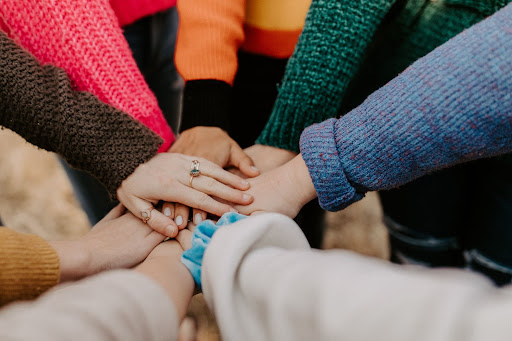Group polarization is an important phenomenon in social psychology and is observable in many social contexts. This phenomenon occurs when a group discussing problems leads to group polarization effects.
Note that group polarization can happen in the direction of either riskiness (risky shift) or conservativeness.
Keep reading to learn 11 strategies to avoid it.
Let’s dive right into it.
1. Treat Everyone With Kindness
Overinvesting in empathy and kindness will reap benefits you’ve never dreamed of.

Many employees are bearing heavier burdens than normal when they’re navigating a highly polarizing external environment.
- Assume the best intentions of others
- Default to empathy
- Replace judgment with respect, permission and acceptance
- Give your colleagues grace when mistakes are made as you work to create a more inclusive culture
2. Encourage Respectful Dialogue
Workplaces benefit by being equipped to welcome the whole human to work, including the broad range of emotions related to the political or social state of the world, country or town.
Create a safety zone where employees can recognize each other for showing up professionally during difficult times in society.
This creates a culture of trust and belonging that encourages honesty, vulnerability and a workplace that supports humanity.
3. Invest In Education Opportunities
Investing in education that balances two or more sides of an issue can encourage people to understand each other better.
Create opportunities to discover and listen to ideas, encourage dialogue to find commonalities and avoid team members being in “monologue” mode.
Overall, encourage kindness!
4. Define Company Behavioral Expectations
Create a culture of treating every group member with the respect and dignity they deserve as fellow human beings and that each person would like to receive themselves.
Making the guidelines clear to all that group values of respect ensure groups discussing problems occur respectfully and safely.
5. Promote Respectful Disagreement
Remind employees they all play for the same team – humanity, and that they should have a baseline of respect and honor for that in every conversation.
Real life is not the internet or the news networks and people often bring the vitriol that is endemic on these outlets into the workplace.
Employees can benefit by remembering it’s possible to respectfully disagree with someone without causing conflict.
6. Have Objective And Constructive Conversations
With group decision making, organizations can be leaders in teaching their employees how to have these discussions objectively.
Teaching employees how to constructively engage in these discussions with their co-workers by being engaged in the discussions at the top and modeling the behavior you wish to lead.
Fostering respect and understanding is the key by communicating that one’s identity is not threatened if others feel or believe something opposite to them.
7. Clearly Define That The Company Aligns With Respect And Kindness
Employees demand from their employers a stake in the ground on key topics. Companies will benefit their employees by identifying a set of guiding principles or group norms and how they align to their purpose, mission and group values.
Employers who want to ensure employees bring their authentic selves to work will create a sanctuary for them to have uncomfortable conversations to move forward the agenda of diversity, inclusion and kindness.
8. Provide Resources To Leaders
Providing employees, especially leaders and HR teams, with balanced resources to lead or manage difficult conversations is critical to support an inclusive environment.
Addressing any situations where polarizing conversations weren’t handled respectfully from a restorative, healing frame of mind is also important.
Lastly, leaders modeling allyship, vulnerability and growth orientation enable a respectful culture.
Related Articles:
Integrated Leadership: Ideas To Be A Better Leader
9. Train Employees In Areas Of Diversity And Inclusion
Creating an inclusive culture is key to fostering an open and honorable space for all. These leadership qualities ensure your employees know how to respectfully engage when potentially polarizing topics arise without using labels.
What’s critical to maintaining a respectful work environment is also being sure employees understand why it’s important to welcome differing points of view.

10. Encourage Employees To Be Themselves
Create an organizational culture that thrives on diversity of thought, empathy and respectful discussion. You can do this without a charter—just live your values out loud.
Encourage your employees to be their whole selves at work. It’s more beneficial when your organizational leaders can set the example so it’s seen from the top down.
11. Encourage Social or Political Groups Or Panels
Work-life balance is now a work-life blend—it’s time for employers to embrace that life happens 24/7.
To do this, businesses can encourage grassroots, peer-to-peer lead resource groups where there can be topic-specific group discussion, also ensuring kindness and respect can be upheld.
Use a communication tool or platform that offers a safe space for continuous discussion.
What Is An Example Of Group Polarization?
Group polarization states it can happen in the direction of either risk taking (risky shift) or conservativeness.
One extreme form is the way in which unruly mobs (e.g., lynch mobs) often commit horrendous acts of violence that no individual member would have been brash enough to attempt on their own (the kidnapping and hanging of humans by the neck until the point of death).
Risk taking can go from bad to worse during sports events. Crowds tend to become more aggressive when the game gets heated. One frustrated fan isn’t so bad, but take a hundred, angry supporters who want to burn the stadium down—now, that’s trouble.
Another example is the way in which relief agencies often attempt and accomplish wonderful acts of benevolence.
Acts where no individual group members would have been ambitious enough to deem possible and then attempt, for example, providing food, clothing, and long-term housing to survivors of natural disasters on their own in the same way like minded individuals can.
Related: Be, Do, Have Model Simplified – 12 Facts To Know
What Is Group Polarization In AP Psychology?
Group polarization occurs when a group makes a more extreme decision than its individual members would have made if acting on their own.
Group polarization is a socio-psychological phenomenon that arises as a result of a group discussion, during which the dissimilar opinions form two polar opposite positions that exclude any compromises.
However, it can also arise outside of open discussion, as a result of systematic exchange of views between participants in joint activities, leading to groupings with polar positions.
Stoner’s (1961) master’s thesis in social psychology describing the discovery of the “risky shift,” which concluded that groups generally behaved in a riskier way (taking bets with higher potential rewards but also lower probabilities) than individuals (Cartwright, 1971).
Although this finding in itself was eventually discredited (Friedkin, 1999), the phenomenon of choice shift continued to motivate research.
Serge Moscovici, a Romanian-born French sociologist, and Marisa Zavalloni, an Italian-born Canadian social psychologist introduced the concept of group polarization.
They studied a group of 140 male secondary school students in group discussions. The students, asked to discuss Charles De Gaulle and America tended to hold views more extremely favoring De Gaulle and disfavoring Americans after the discussion (Moscovici and Zavalloni, 1969).
Myers and Lamm (1978) describe the theoretical underpinnings of group polarization. Of early research in group polarization, several theories dominated:
- social decision rules (ways that individual decisions can form into a group decision)
- informational influence (where people learn as a result of hearing and giving cogent arguments considering the topic at hand)
- social comparison effects
- responsibility dynamics (where having a large number of people in a group may make members feel less responsible for holding accountability for a given decision)
How Does Group Polarization Occur?
Group polarization causes people’s attitudes to intensify. And in effect, their actions become extreme as well, whether benevolent or malicious.
So what causes a group to resort to such behavior? Here are some social psychology theories:
1. Social Comparison Theory
Social comparison theory suggests that individual group members adjust their attitudes to fit in a group with a normative influence. Furthermore, new group members may push for a more extreme point of view and cause others to adopt attitudes that are similar.
2. Social Identity and Self-Categorization
According to these theories, each person has developed a concept associating themselves to a specific group’s beliefs. Similarly, each person also perceives other groups of people into social categories. We often refer to this as stereotyping.
3. Persuasive Arguments Theory
Persuasive arguments theory explains that individual members can be aware of two sides of an issue upon entering a discussion. Yet in the end, they will most likely lean towards a stance that presents more substantial information.
Related: The GRPI Model for Effective Teams
Why Does Group Polarization Occur
One reason for group polarization is the sharing of persuasive alternative perspectives.
For example, when the majority of a group’s members are initially like-minded and in group discussions present evidence that:
(a) support the attitude or action and/or
(b) other group members have not yet considered
then the group members’ initial attitudes will become stronger.
Attitudes of the group then, as a whole, will be stronger compared to the individually assessed attitudes of the members.
Note also that during the sharing of persuasive evidence, group members may have a tendency to reiterate, at least in part, the perspective presented by other group members.
This repetition of ideas also can strengthen the group’s and individuals’ attitudes. Such as when media outlets or leaders of various groups repeat a set phrase or idea and it’s seen or heard over and over.
It’s important to note that when the majority of the group initially is not in agreement and, instead, is split on an issue, depolarization can occur as a result of group members trading persuasive ideas.
Depolarization refers to a shift away from the extremes and toward the middle.
Another explanatory reason for group polarization is when social comparisons tend to influence more extreme positions. For example, one group member may assess other group members’ attitudes and then adopt a similar or more extreme judgment.
People have a tendency to like those who are similar to themselves. It follows then, that if people want to be liked by group members, one way to accomplish this is to have beliefs or attitudes that are consistent with those of the group.

Group Polarization Psychology Definition
According to experimental social psychology, choice shifts occur when, after a group’s interaction, the average attitude of group members differs from the member’s average initial attitude.
Meanwhile, group polarization happens when the choice shift is in the same direction as where the average initial attitude was inclined.
For example, if the average initial attitudes of group members were slightly positive, then the average attitude of members after discussion would be even more positive.
While group polarization always involves a choice shift, choice shift does not necessarily entail group polarization. Cartwright (1971) argued that “risky-shift” literature needed an analysis of the interpersonal influences that led to choice shifts.
Related: What Are Examples Of Effective Team Dynamics
What Is Group Polarization And Groupthink?
Have you agreed to a decision because of peer pressure?
Let’s say you and your friends are in a restaurant and deciding which type of pizza to order. Everyone wanted a Hawaiian pizza, and you’re the only one who wanted Pepperoni.
Deep inside, you know you despise pineapples on pizza. But because of groupthink, you go ahead and agree.
Groupthink happens because a person doesn’t want to disagree with the majority. So, they refuse to bring new ideas to the table or deny doing what they know is right for them. They may also shy away from contradicting others to avoid conflict.
When members of a group succumb to groupthink, they are often pressured into agreeing so they avoid being left out.
Leaders can take advantage of this with policies. As a result, members become “yes men”—people who agree for the sake of the group’s harmony.
This might seem like a favorable setup. But, being a yes man has detrimental consequences to you and other people in your group. Here are some of the effects of groupthink:
- Decision outcomes are dysfunctional, irrational, and lacks critical evaluation
- Without constructive criticism, mistakes are more likely to happen again
- Due to the fear of change, there will be no innovation and development within the group
- Most members become unaware of the current and potential problems
- There’s very little room for the members to be unique and creative
- Members cannot think for themselves. This causes them to do things that they wouldn’t
have done on their own
- The group develops a false sense of confidence. They think they are invulnerable and perfect. This thinking negatively impacts the group’s performance
- There’s an exclusion of people with different beliefs and opinions
Related: TOP Team Building Consulting Firms You Should Know
Group Polarization VS Groupthink
Groupthink refers to a process where a group reaches a consensus without evaluating or critically considering the consequences of the decision reached.
On the other hand, group polarization occurs with a decision-making tactic that focuses on decision making in groups that are more extreme compared to the individual team members’ original views and thoughts.
While groupthink results in decisions made based on the desire of not upsetting a group of people, group polarization results in extremely conservative decisions where the group members are cautious and risky decisions where the group members are risk-averse.
Groupthink versus group polarization in organizations and communities can be dangerous. The in-group believes that they are invulnerable and dominant, and as a result, they can underrate people from the out-group.
Take well established groups like the Ku Klux Klan, for example. The Ku Klux Klan has extreme attitudes that push for a white-supremacist agenda. Their extreme position against people of color creates a polarizing effect on social influence.
They had openly discriminated against and had horrifying violent behavior against Black people to push forward their extreme viewpoint.
As you can see, groupthink can lead to extreme measures. Powerful groups with extreme positions can be a threat to people they consider as “others.”
And so, it’s necessary to dispel groupthink before it gets worse.
How To Avoid Group Polarization
Intergroup contact where people have learned to be open to other points of view. They’ve understood that differing group decisions or beliefs doesn’t take anything away from them.
The “contact hypothesis” suggests that getting to know each other can reduce prejudice between groups. However, social contact can be done well or done badly.
After reading all of this, you might be wondering what you can do to overcome group polarization. Here are a few suggestions:
- When making group decisions, take a silent ballot before any conversation has occurred
- Ask people to do some writing and reflecting about their values before group discussions
- Make one person the designated “devil’s advocate”. Before any decision is made, have this person be the voice of dissent
- If someone belongs to a different group than yourself, take time to learn about their personal beliefs
In order to combat group polarization, it helps to be reminded of people’s individual beliefs. The best way to do this is to have people reflect on their beliefs in writing ahead of time and make decisions privately.
People are much less likely to take on other’s extreme views if they are allowed to express their views anonymously.
In order to live in a collaborative society it’s up to us all to create an attitude change in group polarization.
Related: Cog’s Ladder Easy Explained Including Its Stages
Group Polarization Example
- Book Club:
Consider a book club, where individuals read books ahead of time and then discuss them with other group members.
An individual may have initial attitudes that the book was good, but far from the best book they have ever read. It may even be the view of most other individuals in the book club.
However, when the book club gathers and discusses the book from their various perspectives.
The group points out the good elements of the book, and individual members of the group leave with a more positive opinion of the book then they came in with.
Group polarization occurs here by lifting the group’s attitude to be enhanced and strengthened from thinking the book was merely good to believing that it was excellent.
- Disaster Relief Organization:
Group polarization doesn’t always entail negative effects. Take the example of a disaster relief organization working to determine how much aid to give to a region affected by a hurricane.
Members of the organization may wish to allocate more aid than other members of the government wish, for example.
When these individuals have a discussion, the group’s normative value of giving aid becomes amplified, and as a result, both individuals from the organization and government groups may wish to allocate even more aid after the discussion.
Group polarization creates division. We can see this at work in our political systems. Rather than sitting down and trying to collaborate with individuals, each side writes the other off based on their membership to a group.
Divisions like this happen closer to home as well. Maybe you stopped talking to family members or neighbors because they identify with a certain group of people. Rather than discounting them, see if you can get to know the individual. You might find their ideas are less extreme than you initially thought.
Thank you for reading. Feel free to leave a comment ✅ and we invite you to share this article with friends ✅ that might find it informative.
